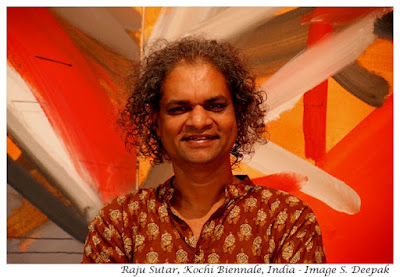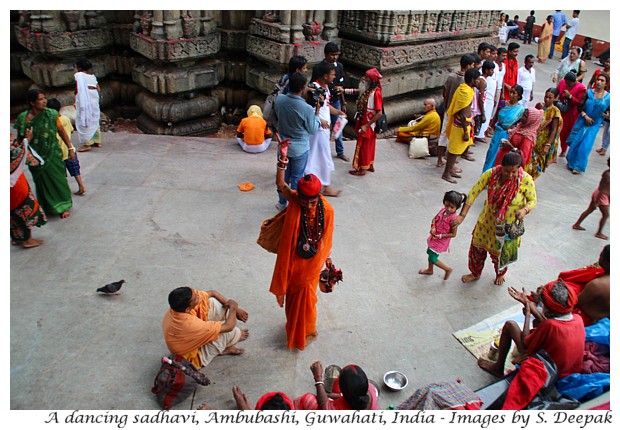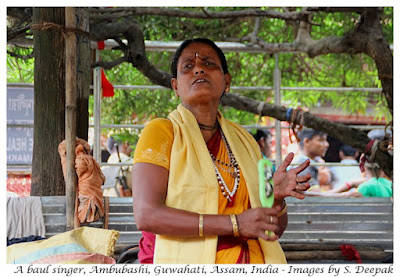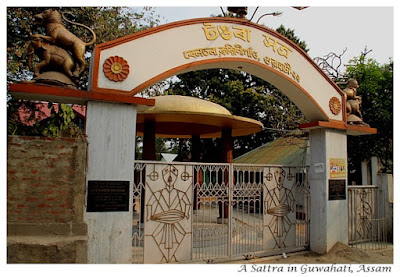At the Kochi Biennale 2018-19 in India, I had a chance encounter with the Pune-based artist Raju Sutar, curator of one of the collateral exhibitions. We talked a little while we sat together to have a coffee. (click on the images for a bigger view)
The Theme of Raju’s Exhibition
Raju had curated the exhibition on the theme of “Thought is Also Matter”, which probed the distinction between conceptual art versus material art and concluded that the distinction is arbitrary, since concepts (thoughts) have material consequences in our brains.I have been to a couple of Biennales in Kochi as well as, once to the Venice Biennale. While visiting the art installations in these events, looking at some of the conceptual art, often I asked myself about the boundaries between art and life, or between an artist and an art appreciator.
A lot of us, including me, we can appreciate art in daily life – from the way nature expresses itself, to casual juxtapositions of colours, forms and ideas in spaces, to the way cobwebs and discarded materials may express concepts. However, my doubt is - Is just appreciating that art-concept in the daily life and putting it together as an art installation, enough to make us an artist?
I think that there can be some extremes of such so called “art-installations” where the artist has conceptualized an art-expression from daily life, to hide his/her laziness and is using creativity to cheat. For example, look at the image below presenting the work “Melting Pot” by the artist Prabhavati Meppayil, which has rubble from a broken wall or a house as an installation. When I saw it in Kochi Biennale 2016-17, I thought that rubble can be artistic and it can have deeper significance of what it says about life, death, time and memories. Yet, an installation like it blurs the boundaries between an artist and appreciating art in daily life, and it probably illustrates my point about lazy artist.
Different forms of Art
One of the deepest emotional experiences for me in this year’s Kochi Biennale was the video and sound installation by the Iranian artist Shirin Neshat called Turbulent with two singers on two screens, one male and one female, on the two sides of a room. Yet, I wondered, how was this different from a film shown in a film festival? Does it mean that different art forms – dance, sculptures, films, singing, can be mixed and presented in all kinds of festivals? That thinking of different art forms and expecting to see specific things in an exhibition is old-fashioned? Isn't that taking and stretching the basic idea of "everything can be art" a bit too far, not in real life, but in organising art festivals?
Thought is Also Matter
Sorry for wandering off in different directions - let me get back to my discussion with Raju.He explained that the idea of this exhibition came from the works of the American neuroscientist Candace Beebe Pert who had discovered the opiate receptor in the brain which binds the endorphins and who proved that thoughts result in chemical changes in the brain and thus turn into matter.
“Neuropeptide is a chemical protein. In reality it’s a piece of matter. And the mind-blowing truth is that it’s a new little piece of universe that didn’t exist just moments before”, he explained.
The exhibition “Thought is also matter” presents the works of a collective of artists from Pune, most of whom had been part of another exhibition called “Roots/Routes” curated by Raju in Kochi Biennale 2016-17. He said that once he had the theme of the exhibition, he talked with the other artists and together started reflections on how this idea can be expressed in different ways.
Apart from Raju’s own works, the other artists in this exhibition were Hrishikesh Pawar, Rajesh Kulkarni, Sandip Sonawale and Vaishali Oak. Let me share some information regarding their works.
Raju Sutar
Raju had paintings on huge canvases covering the whole wall. About these works he said, “Time is made of past, present and future. The past is in the memory and the future is in the imagination. ‘Now’ is present and in a moment, it becomes the past. This ‘now’ is the result of the past and it will shape the future. In fact, now, past and future are all together in one. I am trying to paint large canvasses in a kind of action painting way, as an action is now and not a moment of thought … by avoiding the movement of thought I am trying to look at the possibility of mutation to happen in the moment of ‘now’.”Hrishikesh Pawar
Rajesh Kulkarni
Sandip Sonawale
Sandip is an artist and also runs a printing press. For this exhibition, he expressed himself through colours and basic forms such as circles and triangles.Vaishali Oak
Vaishali had 4 works in the exhibition, all made from fabric assemblage which expressed the idea of “Seed Post”. She works with fabrics, joins pieces together, layering them, and creating textures. She has been honoured by the National Academy Award from Lalit Kala Academy.Discussions with Raju Sutar
Apart from the installations in the exhibition, we also talked about some other issues related to art and artists in India. Raju teaches art and yet he said that he did not believe in formally trained artists and is open to persons who take up art because they have a passion for it.I was a little surprised, so he explained, “Hardly any students come to study art because they are passionate about it. Most students in art college are there because they did not get admission in any other college. You can see in the class that they have no real interest in it.”
I could understand his point but I felt that he was too harsh. It may be true for most students in an art college, that they did not get admission in other more prestigious colleges/courses. Yet, in the end, they chose an art college, so perhaps they did have some interest in the subject.
He also felt that Kochi biennale is the biggest and most significant art movement in post-independence India. He was critical towards the ‘latest art fad’, that of the Conceptual art. He felt that sometimes it was all about concept and ignored the canvas, while for an artist, the canvas has to be important. He told me about a discussion he had many years ago with the well-known artist, M.F. Hussein saheb, “He said that these fads are iconic entertainment.”
In a way, the exhibition he has curated ‘Thoughts are also matter’ is an expression of his dissent with the way conceptual art is being used. “Today there is great insistence on concepts and everything else is looked down and is considered of less importance. I was thinking about the origin of the idea of conceptual art, and challenging it in different ways. I was interested in finding what is not a thought.”

































